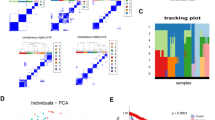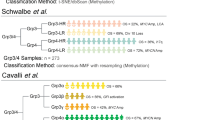Abstract
Clinical behavior of neuroblastoma (NBL) is remarkably heterogeneous, as it ranges from spontaneous regression to aggressive clinical phenotype and death. There is increasing body of evidence demonstrating that microRNAs could be considered the potential biomarkers for clinical applications in NBL. In this report, we focus on molecular characterization of high-risk as well as low-risk and intermediate-risk NBL cases in the context of the microRNA expression profile that is specific for the given risk category of the disease. We investigated a total of 30 NBL patients, out of whom there were 19 patients with low- to intermediate-risk and 11 with high-risk NBLs as defined by the Clinical Oncology Group. We determined the expression profiles of 754 microRNAs (miRNAs), whereas the miRNA expression levels were normalized to RNU44, mean expression levels were calculated, and data were analyzed by use of the microarray biostatistical approaches. We identified the signature of 38 miRNAs differentially expressed between these groups of NBL patients (P < 0.05): 17 miRNAs were upregulated and 21 miRNAs were downregulated in the tumors of high-risk NBL patients. We confirm some of the previous observations and we report several new microRNAs associated with aggressive NBL, both being relevant subjects for further translational validation and functional studies.

Similar content being viewed by others
Abbreviations
- Bcl2:
-
B cell lymphoma
- COG:
-
Children’s Oncology Group
- HR:
-
High risk
- IMR:
-
Intermediate risk
- INPC:
-
International Neuroblastoma Pathology Classification
- INSS:
-
International Neuroblastoma Staging System
- miRNA:
-
microRNA
- MYCN:
-
V-myc myelocytomatosis viral-related oncogene, neuroblastoma-derived (avian)
- NBL:
-
Neuroblastoma
- NEUROD1:
-
Neurogenic differentiation 1
- LR:
-
Low risk
- TLDA:
-
TaqMan low-density arrays
- TrkA/TrkB:
-
Tyrosin-related kinase A/tyrosine-related kinase B
References
Brodeur GM. Neuroblastoma: biological insights into a clinical enigma. Nat Rev Cancer. 2003;3(3):203–16.
Park JR, Eggert A, Caron H. Neuroblastoma: biology, prognosis, and treatment. Pediatr Clin North Am. 2008;55(1):97–120.
Speleman F, De Preter K, Vandesompele J. Neuroblastoma genetics and phenotype: a tale of heterogeneity. Semin Cancer Biol. 2011;21(4):238–44.
Iorio MV, Croce CM. MicroRNA dysregulation in cancer: diagnostics, monitoring and therapeutics. A comprehensive review. EMBO Mol Med. 2012;4(3):143–59.
Croce CM. Causes and consequences of microRNA dysregulation in cancer. Nat Rev Genet. 2009;10(10):704–14.
Chen Y, Stallings RL. Differential patterns of microRNA expression in neuroblastoma are correlated with prognosis, differentiation, and apoptosis. Cancer Res. 2007;67(3):976–83.
Bray I, Bryan K, Prenter S, Buckley PG, Foley NH, Murphy DM, et al. Widespread dysregulation of MiRNAs by MYCN amplification and chromosomal imbalances in neuroblastoma: association of miRNA expression with survival. PLoS One. 2009;4(11):e7850.
Schulte JH, Schowe B, Mestdagh P, Kaderali L, Kalaghatgi P, Schlierf S, et al. Accurate prediction of neuroblastoma outcome based on miRNA expression profiles. Int J Cancer. 2010;127(10):2374–85.
Buckley PG, Alcock L, Bryan K, Bray I, Schulte JH, Schramm A, et al. Chromosomal and microRNA expression patterns reveal biologically distinct subgroups of 11q- neuroblastoma. Clin Cancer Res. 2010;16(11):2971–8.
Guo J, Dong Q, Fang Z, Chen X, Lu H, Wang K, et al. Identification of miRNAs that are associated with tumor metastasis in neuroblastoma. Cancer Biol Ther. 2010;9(6):446–52.
Schulte JH, Marschall T, Martin M, Rosenstiel P, Mestdagh P, Schlierf S, et al. Deep sequencing reveals differential expression of microRNAs in favorable versus unfavorable neuroblastoma. Nucleic Acids Res. 2010;38(17):5919–28.
Gattolliat CH, Thomas L, Ciafre SA, Meurice G, Le Teuff G, Job B, et al. Expression of miR-487b and miR-410 encoded by 14q32.31 locus is a prognostic marker in neuroblastoma. Br J Cancer. 2011;105(9):1352–61.
Lin RJ, Lin YC, Chen J, Kuo HH, Chen YY, Diccianni MB, et al. microRNA signature and expression of Dicer and Drosha can predict prognosis and delineate risk groups in neuroblastoma. Cancer Res. 2010;70(20):7841–50.
De Preter K, Mestdagh P, Vermeulen J, Zeka F, Naranjo A, Bray I, et al. miRNA expression profiling enables risk stratification in archived and fresh neuroblastoma tumor samples. Clin Cancer Res. 2011;17(24):7684–92.
De Brouwer S, Mestdagh P, Lambertz I, Pattyn F, De Paepe A, Westermann F, et al. Dickkopf-3 is regulated by the MYCN-induced miR-17-92 cluster in neuroblastoma. Int J Cancer. 2011;130(11):2591–8.
Tivnan A, Tracey L, Buckley PG, Alcock LC, Davidoff AM, Stallings RL. MicroRNA-34a is a potent tumor suppressor molecule in vivo in neuroblastoma. BMC Cancer. 2011;11:33.
Zheng H, Zeng Y, Zhang X, Chu J, Loh HH, Law PY. mu-Opioid receptor agonists differentially regulate the expression of miR-190 and NeuroD. Mol Pharmacol. 2009;77(1):102–9.
Liu Y, Encinas M, Comella JX, Aldea M, Gallego C. Basic helix-loop-helix proteins bind to TrkB and p21(Cip1) promoters linking differentiation and cell cycle arrest in neuroblastoma cells. Mol Cell Biol. 2004;24(7):2662–72.
Ryan J, Tivnan A, Fay J, Bryan K, Meehan M, Creevey L, et al. MicroRNA-204 increases sensitivity of neuroblastoma cells to cisplatin and is associated with a favourable clinical outcome. Br J Cancer. 2012;107(6):967–76. doi:10.1038/bjc.2012.356.
Yang Z, Ren F, Liu C, He S, Sun G, Gao Q, et al. dbDEMC: a database of differentially expressed miRNAs in human cancers. BMC Genomics. 2010;11 Suppl 4:S5.
Acknowledgments
This study was funded by the Childhood Cancer Foundation—Krtek, by the Institutional Resources for Supporting the Research Organization provided by the Ministry of Health of the Czech Republic in 2012, and by the project “CEITEC—Central European Institute of Technology” (CZ.1.05/1.1.00/02.0068) and “RECAMO—Regional Centre for Applied Molecular Oncology” (CZ.1.05/2.1.00/03.0101).
Conflicts of interest
None
Author information
Authors and Affiliations
Corresponding author
Rights and permissions
About this article
Cite this article
Bienertova-Vasku, J., Mazanek, P., Hezova, R. et al. Extension of microRNA expression pattern associated with high-risk neuroblastoma. Tumor Biol. 34, 2315–2319 (2013). https://doi.org/10.1007/s13277-013-0777-0
Received:
Accepted:
Published:
Issue Date:
DOI: https://doi.org/10.1007/s13277-013-0777-0




